#kept thinking how well crowley would suit the black/white style like that; and I believe I was correct :3c
Explore tagged Tumblr posts
Text

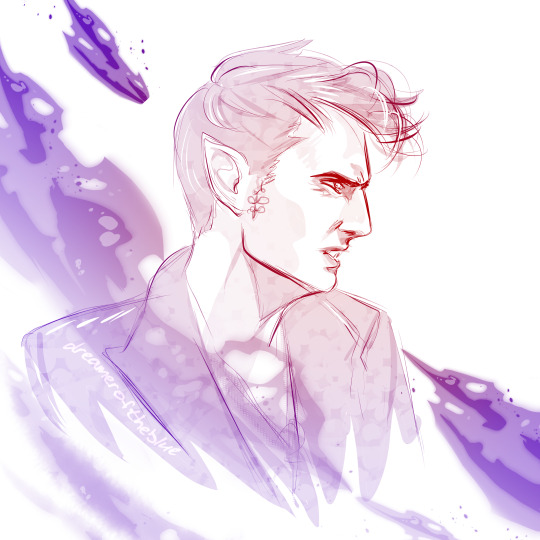
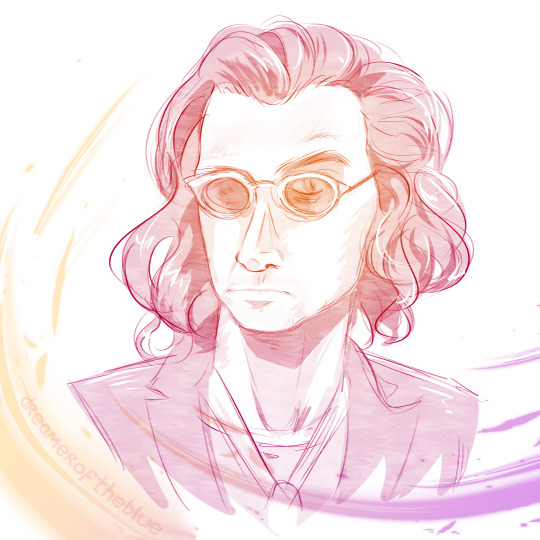
mentally I am chewing on him like a stim toy
#ha ha ha ha I said no more crowley until I finish some commission work#well. I made enough progress. that I allowed myself a two hour fervor with which to pump these all out#just opened some pics from the ref folder and there we go#kept thinking how well crowley would suit the black/white style like that; and I believe I was correct :3c#you know how someone's art really conveys what they love#I hope my love always rings loud and clear and obvious#love letters to him and mister tennant and you lovely folk who keep putting out nice things for me to see with my own eyes. for free. muah#crowley#good omens#good omens fanart#good omens crowley#anthony j crowley#david tennant#due for some more angel practice probably too#we shall s e e
102 notes
·
View notes
Text
I Got Rhythm: Costuming “An American In Paris,” Part I
Hello, dear readers, and welcome back to Broadway by Design! After taking a look at some unorthodox costumes in my Tanz der Vampire/Le Bal des Vampires, I’m shifting gears back towards traditional Broadway, this time with a still-Parisian twist. By request from an Anon (and with encouragement from my dear friend @annbradleys ), I’m moving up my review of Bob Crowley’s couture-inspired designs from An American in Paris, and I can’t wait to get started!
For those not familiar with this production, it takes its lead from the 1951 movie of the same name. Stunningly for an Oscar-winning production in this era, the costumes for the movie were not Edith Head, but were a team effort by Orry-Kelly, Walter Plunkett, and Irene Sharaff. For the stage production, Bob Crowley definitely took some inspiration from the original movie, but moved in a new direction that was inspired by the high fashion (couture) of post-war France, which means his costumes are elegant, simple, and visually appealing. Let’s dive in, this time with images courtesy of Vanity Fair, which spent quite a bit of time promoting the production:

I’m starting with a group shot for a reason: it gives us an idea of where the costumes start before we begin to look at some of the more unique designs that were given to individual actors and ensemble members. The production is set in post-war Paris, so it makes sense that (especially on the female members of the cast) the costumes are somewhat demure. The style on the women’s dresses are similar, but with an air of refinement in each of them. I like how, despite similar fabrics and patterns, the cut on the green and red-orange dresses on the righthand side are quite different, with the latter sporting a doubled look and the one on the right looking a bit more timeless and classical. The dress in the center and on the left both share that timelessness, but in shades of color that are simply ravishing. I’m not as much of an expert on male costuming, but the mens’ suits are visually appealing and fit the era (late 1940s) extremely well. It’s difficult to get a suit wrong but believe it or not, I have seen it done.
The same Vanity Fair coverage gave us insight into Bob Crowley’s design processes for well, especially for the more elaborate costumes. Below, I’ve included a couple of his design sketches so I can comment a little on that process before proceeding to look at some of the more visually appealing dresses that appear in this production:
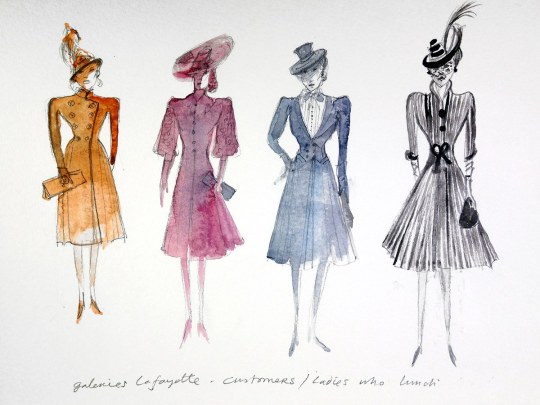
(Caption: Galeries Lafayette - Customers/Ladies who lunch)

(Caption: Milo Davenport | Ritz | Chaldet AAIP Ballet, with side notation indicating there is a fur wrap)
Color sketches are how a costume designer first lays out his or her vision for the wardrobe department. A designer, while intimately involved in every aspect of producing a costume, is not a single force and works with an extensive team in the costume shop of the theatre. This includes any number of tailors and seamstresses who will do the actual work of assembling the outfits to the people who add jewel or beadwork, all to the designer’s exacting specifications. But these sketches, often done in pencil and watercolor for intensity of color, are where it all begins. Notice how not every detail is outlined at this early stage; even if these are what the public envisions when they think of designer sketches, they aren’t the finished product. This, however, is how the work gets started and it can take an enormous amount of back-and-forth consultation between the costume designer, the costume shop, the set designer (can’t have color clashes or competition for the audience’s attention!), and even the actor or actress who will wear the finished product. The idea is to give a rough expectation of the finished product while allowing the flexibility to make changes for later. It’s the same process used by fashion designers making regular clothing or runway dresses, but with a different set of people consulted at each step.
Bob Crowley’s designs, as the sketches show, reflect a classic look, something a bit more sophisticated than many of the dresses I have reviewed recently. That’s intentional given the time setting of An American in Paris; as I noted in my reviews of War Paint, the post-war era is where couture really started to come into its own. The designs reflect that while making sense in the context of the musical. There’s a tremendous use of color in the sketches, and that later gets transformed into some beautiful costume designs for the Milo character in particular. With thanks to BroadwayBox, I want to look at a few outfits Milo wears in particular:

I started with this outfit for Milo (as played ably by Jill Paice) because, lo and behold, it matches one of Bob Crowley’s design sketches above! What was once simply pencil and watercolor has now become a far more complex and complete costume from head to toe. We can see that he kept the same red for the dress as in the sketch, as well as the bow-like adornment that lies on the character’s waist. The coat has changed dramatically (remember what I said about sketches changing often?) and is now a black-and-red checked pattern rather than white-and-red, which I think makes it seem much more dramatic. The fabrics are rich and hang well, and there is simple accenting in the form of black suede gloves (according to Ms Paice herself), wide-brimmed hat that accentuates her blonde hair, and a relatively simple gold chain. It’s a visually impressive piece, and I love the way it just looks classical!

Second, we have this green, silky number that goes down to Ms Paice’s ankle. For the most part, it’s a simple dress with a traditional off-the-shoulder look that would have fit in at any swanky 1940s cocktail party (and indeed this costume makes an appearance in a scene set in the Ritz Hotel in Paris), especially on the figure of a wealthy woman like Milo. The lines are very classic and the fabric just looks so rich; having worked mostly in college productions, I can only dream of working with something this fine. But there is an additional element that I absolutely love about this one: the extra flare of silk on the left portion of the bust (viewer’s left, wearer’s right). It takes this dress from simply something that could appear in a Macy’s or Neiman Marcus window and elevates it to couture, a custom fashion made specifically for the wearer.
And one more thing about this dress: it flows, oh does it flow:

It floats outward and immediately comes back into place without looking wrinkled or shabby, and that is the sign of some truly quality work in any production, let alone one by Bob Crowley.

Next, we have an amazing skirtsuit that really shouts out for some analysis. A black A-line skirt is complemented and popped by the leopard-print blouse that imbues the character with two things: a sense of power and a sense of fun. During my review of Christine Ebersole’s wardrobe, I talked about the idea of power suits, and this definitely falls into that category. The cut of the dress (an A-Line) coupled with the color make clear that this is a serious person with serious business and ideas, while the blouse makes it clear that lurking underneath (literally!) there is a fun and vivacious character to be found. With very simple jewelry, the simple nature of the dress is allowed to carry the day, with the blouse itself acting as the accessory. Very clever mixture of techniques that I like!

This gown made its appearance in the Broadway debut of An American in Paris, appearing in the Bal des Beaux-Arts scene where everyone (or almost everyone) is enjoying a masquerade ball. For those who are fans of Phantom of the Opera, the concept of a masquerade ball is not alien; everyone wears their fanciest, most memorable couture and everyone carries or wears a simple mask that is adorned with beads, jewels, and/or feathers in order to conceal their identity.
Milo’s masquerade gown harkens back to the red-and-black checked coat at least in color scheme, and that’s something that I like--but the similarities end there. The skirt is ruffled with layers of what seems to be chiffon, while the black covering is a much smoother, more satiny fabric. Jill Paice said it was her favorite gown of the Broadway production because of the way it allowed her to move and breathe; because the dress is puffed out and because the black is fit to her figure, there’s no need for a corset or other structure underneath. That’s why it looks a little bit smoother in some regards on her upper body.
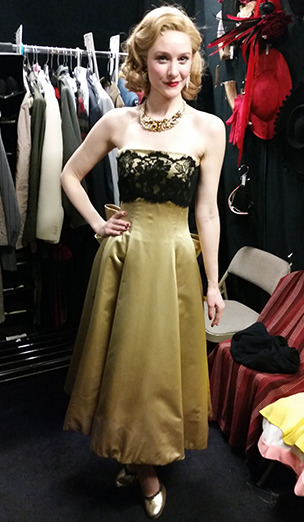
This dress appears at the beginning of Act II and is another entry in the couture-inspired designs. There’s some classic French and Hollywood glamor on display here, from the bodice that has an almost sensual black lace to the way the dress hangs elegantly without flowing too much; it’s definitely the kind of dress you expect to be seen in, rather than, say, go dancing intensely. While it’s not apparent in this shot, you can just see the hints of a large bow fixed at the back of the dress, a mark of custom design that once again reinforces that we are dealing with a character of means. The accessories are once again relatively simple; Milo Davenport is a character whose wealth and elegance speak for themselves. She doesn’t need fancy jewelry, though the necklace adorning her neck is a beautiful gold number that matches the tones of the dress well.
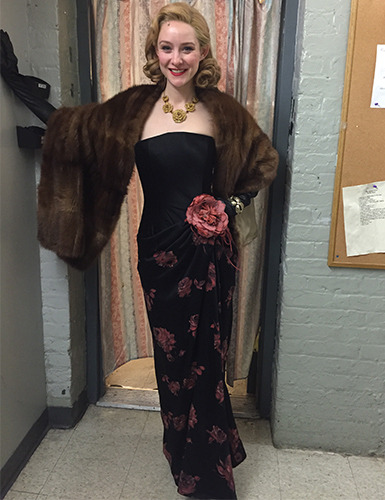
The last outfit of Milo’s I’ll cover is this number from the finale of Act II. Here, I must confess, I am not as avid a fan of Bob Crowley’s design as I am for some of the other pieces. I like the way the large floral adornment acts as a bridge between the patterned skirt and the un-patterned top of the dress, but the pattern itself strikes me as dated--even in the context of a 1940s-set musical. To be clear, I don’t object to floral patterns in general; indeed, I think Paloma Young did a beautiful job with them in Bandstand. But this one falls a little flat to me. Compared to the other costumes prepared for the character of Milo, this one just feels a bit more low-market. I freely admit that this may be a matter of personal taste, and I won’t criticize the work that went into it, but it just feels like it would have been better with either a different, more subtle pattern, or even as a black dress with some kind of accessories. One positive I will give it, however, is that it does hang well on Ms Paice and the fur stole/wrap really does do it justice.
And here’s the biggest reason I’m not as huge a fan: this dress started out as the dress on the far right of the Milo sketches that I posted earlier. There, it had a subtle pink skirt with the rose adornment. It was sleek and classical without being overly dramatic, and it avoided the somewhat dull pattern work that the final number had. But remember what I said: sketches are just the starting point. Clearly, someone (perhaps Mr Crowley himself!) decided that the final number needed to have Milo in a patterned skirt. It was a judgment call, and while I didn’t love it, I am sure there are many fans of the musical who did.
Overall, I really am in love with the classic, clean, couture look of the musical’s costuming, especially the majority of the dresses prepared for the Milo character. Bob Crowley is a master of the costuming arts and created some truly elegant and beautiful designs, even if I didn’t always agree with his choices. What makes them work is not only that they fit the era of the musical, but that they fit the personality of the character and the actress portraying her as well. On the whole, I can’t really find much to do but celebrate the way this turned out.
Next, I’ll take a look at some of the other costumes in this utterly lavish production, including those of the leading lady in An American in Paris. Bob Crowley put so much work into this musical that it’s only fair to give his costumes the full attention that they deserve.
Stay tuned!
100 notes
·
View notes